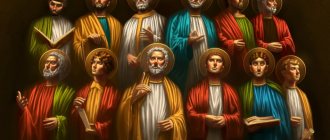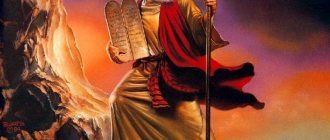Interpretation of the New Testament
The New Testament (abbreviated NT) is a collection of 27 books of ancient Christian manuscripts in ancient Greek.
The center of the content of the New Testament is the saving mission of Jesus - the Son of God and the Messiah - in relation to humanity.
The New Testament is the second main part of the Kingi, the world's best-selling Bible. The Bible itself is considered by all movements of Christianity as the basis of faith in God.
More about the New Testament
The earliest papyrus containing the first book of the New Testament that has been found to this day. The papyrus dates back to the 2nd century AD. and exhibited at the Bible House in Frankfurt am Main (Germany)
Comments and illustrations
About the New Testament From Matthew From Mark From Luke From John Acts James 1 Peter 2 Peter 1 John 2 John 3 John Jude Romans 1 Corinthians 2 Corinthians Ephesians Thessalonians 1 Timothy Hebrews Revelation
Explanatory BibleNew Testament
The word “canon” (κανών) originally meant “reed”, and then began to be used to designate what should serve as a rule, a pattern of life (Gal. 6:16; 2 Cor. 10:13–16). The Church Fathers and Councils used this term to designate a collection of sacred, inspired writings. Therefore, the canon of the New Testament is the collection of the sacred inspired books of the New Testament in its present form3.
What was the primacy of the Church guided by when it accepted this or that sacred New Testament book into the canon? First of all, the so-called historical
by legend.
They investigated whether this or that book had actually been received directly from an apostle or an apostolic co-worker, and, after a strict study, they included this book among the inspired books. But at the same time, they also paid attention to whether the teaching contained in the book in question was consistent, firstly, with the teaching of the entire Church and, secondly, with the teaching of the apostle whose name this book bore. This is the so-called dogmatic
tradition. And it has never happened that the Church, once recognizing a book as canonical, subsequently changed its view of it and excluded it from the canon. If individual fathers and teachers of the Church even after this still recognized some New Testament writings as inauthentic, then this was only their private view, which should not be confused with the voice of the Church. In the same way, it has never happened that the Church first did not accept any book into the canon, and then included it. If some canonical books are not indicated in the writings of the apostolic men (for example, the Epistle of Jude), this is explained by the fact that the apostolic men had no reason to quote these books.
Thus, the Church, through critical examination, on the one hand, eliminated from general use those books that unlawfully used the authority of truly apostolic works, on the other hand, established as a general rule that in all churches those books that, perhaps, were recognized as truly apostolic were unknown to some private churches. From this it is clear that from the Orthodox point of view one can speak not of the “formation of a canon,” but only of the “establishment of a canon.” The Church did not “create anything out of itself” in this case, but only, so to speak, stated precisely verified facts of the origin of the sacred books from the famous inspired men of the New Testament.
This “establishment of the canon” continued for a very long time. Even under the apostles, there undoubtedly existed something like a canon, which can be confirmed by the Apostle Paul’s reference to the existence of a collection of the words of Christ and the Apostle Peter’s reference to the collection of Paul’s Epistles (2 Pet. 3:15-16). According to some ancient interpreters, for example Theodore of Mopsuestia, and new ones, for example Archpriest. A.V. Gorsky, the Apostle John the Theologian worked the most in this matter (“Addition to the works of the holy fathers.” T. 24. pp. 297–327).
But actually the first
The period of canon history is the period of apostolic and Christian apologists, lasting approximately from the end of the 1st century until the year 170. During this period, we find, for the most part, quite clear indications of the books included in the New Testament canon, but the writers of this period still very rarely directly indicate from which holy book they take this or that passage, so that we find among them the so-called “ dumb quotes." Moreover, as Barth says in his “Introduction to the New Testament” (ed. 1908, p. 324), in those days spiritual gifts were still in full bloom and there were many inspired prophets and teachers, so look for primary sources for your teachings writers of the 2nd century could not in books, but in the oral teachings of these prophets and in general in oral church tradition.
In the second
period, lasting until the end of the 3rd century, more definite indications appear of the existence of the composition of the New Testament sacred books accepted by the Church. Thus, a fragment found by the scientist Muratorius in the Milan library and dating back to approximately 200–210. according to R.H., gives a historical overview of almost all New Testament books: only the Epistle to the Hebrews, the Epistle of James and the 2nd Epistle of the Apostle Peter are not mentioned in it. This fragment testifies, of course, mainly to the composition of the canon established by the end of the 2nd century in the Western Church. The state of the canon in the Eastern Church is evidenced by the Syriac translation of the New Testament, known as the Peshitta. This translation mentions almost all of our canonical books, with the exception of the 2nd Epistle of the Apostle Peter, the 2nd and 3rd Epistles of John, the Epistle of Jude and the Apocalypse. Tertullian testifies to the state of the canon in the Carthaginian Church. He certifies the authenticity of the Epistle of Jude and the Apocalypse, but does not mention the epistles of the Apostle James and the 2nd Epistle of the Apostle Peter, and attributes the Epistle to the Hebrews to Barnabas. Saint Irenaeus of Lyons is a witness to the beliefs of the Gallic Church. According to him, in this Church almost all of our books were recognized as canonical, with the exception of the 2nd Epistle of the Apostle Peter and the Epistle of Jude. The Epistle to Philemon is also not quoted. Saints Clement of Alexandria and Origen testify to the beliefs of the Alexandrian Church. The former used all the New Testament books, and the latter recognizes the apostolic origin of all our books, although he reports that regarding the 2nd Epistle of Peter, the 2nd and 3rd Epistles of John, the Epistle of James, the Epistle of Jude and the Epistle to the Hebrews there were disagreements in his time .
Thus, in the second half of the 2nd century, the following sacred books were undoubtedly recognized as inspired apostolic works throughout the Church: the four Gospels, the book of the Acts of the Apostles, the 13 Epistles of the Apostle Paul, 1 John and 1 Peter. Other books were less common, although they were recognized by the Church as authentic.
On the third
period, extending to the second half of the 4th century, the canon is finally established in the form in which it currently exists. Witnesses of the faith of the entire Church here are Eusebius of Caesarea, Saints Cyril of Jerusalem, Gregory the Theologian, Athanasius of Alexandria, Basil the Great, and others. The first of these witnesses speaks most thoroughly about the canonical books. According to him, at that time some books were recognized by the entire Church (τὰ ὁμολογούμενα), namely, the four Gospels, the book of Acts, the 14 Epistles of the Apostle Paul, 1 Peter and 1 John. Here he includes, however with a reservation (“if it pleases”), the Apocalypse of John. Then he has a class of controversial books (ἀντιλεγόμενα), divided into two categories. In the first category he places books that are accepted by many, although controversial. These are the Epistles of James, Jude, 2 Peter and 2 and 3 John. To the second category he includes forged books (νόθα), such as the “Acts of Paul” and others, as well as, “if it pleases,” the Apocalypse of John. He himself considers all our books to be genuine, even the Apocalypse. The list of books of the New Testament found in the Easter letter of St. received a decisive influence in the Eastern Church. Athanasius of Alexandria (367). Having listed all 27 books of the New Testament, St. Athanasius says that only in these books is the teaching of piety proclaimed and that nothing can be taken away from this collection of books, just as nothing can be added to it. Taking into account the great authority that St. had in the Eastern Church. Athanasius, this great fighter against Arianism, we can confidently conclude that the canon of the New Testament he proposed was accepted by the entire Eastern Church, although after St. Athanasius did not follow any conciliar decision regarding the composition of the canon. However, it should be noted that St. Athanasius points out two books that, although not canonized by the Church, are intended for reading by those entering the Church. These books are the teachings of the (twelve) apostles and the shepherd (Hermas). He rejects everything else as heretical fabrication (i.e., books falsely called apostolic).
In the Western Church, the canon of the New Testament in its present form was finally established at the Councils in Africa - the Council of Hippo (393) and the two Councils of Carthage (397 and 419). The canon of the New Testament adopted by these Councils was sanctioned by the Roman Church by decree of Pope Gelasius (492–496).
Those Christian books that were not included in the canon, although they expressed claims to this, were recognized as apocryphal and destined almost for complete destruction4.
Donald Carson - New Bible Commentary Part 1 (Old Testament)
1 …279
New Bible Commentary
Part 1 (Old Testament)
BOOK OF GENESIS - BOOK OF JOB
Preface
For three years we, as editors, have had the privilege and pleasure of being in the midst of a flurry of activity. Others worked hard, and we delved into their work. We are fortunate to be among those whom God has called to work on this grand project, and above all we must thank them for their titanic efforts and for the patience with which they endured our instructions, interventions and periodic proposals to rework what had been done. We were surrounded by a wonderful group of biblical scholars, to whom we are deeply grateful.
As is always the case with those who seek publication with Inter-Varsity Press, we had excellent professional support. By mentioning the names of Managing Editor Derek Wood and Coordinating Editor Sue Rebis, we take the shortest route to convey our gratitude to all IVP staff who directly or indirectly contributed to the publication of this Commentary. Perhaps they wanted us to work faster and write more vividly, but they were still patient. They deserve not only our gratitude, but also the gratitude of all those who will use this Commentary with pleasure and benefit for themselves.
A one-volume commentary on the entire Bible required extreme laconicism and strict selection of material. We have chosen to focus on the "flow" of books and passages in order to provide significant assistance in understanding the Bible. Too often, Bible readers (and not just beginners) suffer because they lack guidance to help them see the forest for the trees. We hope that if our Commentary is used for this purpose, it will be of considerable benefit to the reader. Nevertheless, as far as space permitted, we have endeavored not to neglect a detailed consideration of the difficulties of the text. In any case, we have provided all articles with lists of additional literature. As a rule, these lists reflect a gradually increasing level of requirements placed on the reader. The books at the beginning of each list are designed to satisfy the needs of those readers who want to move from this Commentary to a more thorough acquaintance with the Holy Scriptures. These, in essence, are our main motives and beliefs. We believe that for every Christian and for the church as a whole, nothing is more important in our time than to know, love and obey the Bible as God's Word. It is this cause that we wish to serve, and it is for this purpose that we prayerfully send our Commentary on its way.
This is the second, revised and revised edition of the New Bible Commentary, first published in 1953. As editors, we enjoy the privilege of standing at the very beginning of a proud tradition. We deeply honor the memory of Francis Davidson, Ernest Kevan, Alan Stibbs, Donald Guthrie, true scholars of the Word of God, who now enjoy heaven. We gratefully acknowledge the collaboration and consultation of Donald Wiseman during the publication of the New Bible Commentary Revised. Our respect for these men and their God-given talents is shared by millions of grateful readers around the world. This edition of the New Bible Commentary retains nothing from the 1953 edition and almost nothing from the 1970 edition. We have moved from the Revised Standard Version to the New International Version as the primary English Bible, and God has called a new international team of authors to work. Even when the author of the article is the same as in 1970, the article is either rewritten or completely revised and corrected.
But above all these changes rises the unchangeable God and the unchangeable power of His inspired Word. We dare not compare ourselves with the titans of the past, but we look to heaven prayerfully, hoping that God will once again allow the New Bible Commentary to benefit believers and serve to His glory.
Carson D. A. France R. T. Motyer J. A. Wenham G.J.
Explanations
Order of articles. The commentaries follow the same order as the biblical books; if necessary, they are accompanied by explanatory articles. (See contents.)
Bible references are given in the usual form: chapter, verse, other verse(s). For example, Isa. 53:1-3,10-12 means: The book of the prophet Isaiah, chapter fifty-three, verses 1 to 3 and verses 10 to 12. For abbreviations for the names of biblical books, see the list of abbreviations on p. 8.
If a verse number is followed by a letter, this indicates the beginning or end of the verse (a or b). Sometimes, especially in poetic passages (for example, from the Psalter), the letter indicates the corresponding line in the Bible text. Yes, Ps. 48:15vg refers to the 3rd and 4th lines of the 15th verse of the 48th psalm.
Additional literature. Lists of additional literature are provided in each article. They are arranged in such a way that the easier books are listed at the beginning, and the more difficult ones at the end. The lists do not include any special works. A long line indicates that this book has the same author as in the previous paragraph.
Dating. In a work as large as this Commentary, written by nearly 45 authors, there may well be minor discrepancies in dates. Regarding the dates of ancient history, not all scientists are of the same opinion. For example, there is ongoing debate about the date of the Exodus, which affects the dating of the conquest and the judges. This issue is discussed in the Commentary. However, we have made every effort not to mislead the reader. The agreed chronological table is placed on p. 60-63.
Authors of articles[1]
Alexander T. Desmond. B.A., Ph.D., Lecturer in Semitic Studies, The Queen's University of Belfast, UK. — Alexander, T. Desmond, B.A., Ph.D., Associate Professor of Semitic Studies, Queen's University Belfast, UK. The second book of Moses. Exodus
Baldwin Joyce G. V. A., B. D., formerly Principal, Trinity College, Bristol, UK. — Baldwin, Joyce J., B.A., B.D., former Principal of Trinity College, Bristol, UK. Book of Ruth, Book of Esther
Bimson John JBA, Ph.D., Lecturer in Old Testament and Hebrew, Trinity College, Bristol, UK. — Bimson, John J., B.A., Ph.D., Associate Professor of Old Testament and Hebrew, Trinity College, Bristol, UK. Third and Fourth Books of Kings
Carson Donald ABSc, M.Div., Ph.D., Research Professor of New Testament, Trinity Evangelical Divinity School, Deerfield, Illinois, USA. — Carson, Donald A., B.S., M.D., Ph.D., Professor of New Testament, Trinity Evangelical Divinity School, Deerfield, Illinois, USA. Approaching the Bible; Reading the messages
Clines David JAMA, Professor of Biblical Studies, University of Sheffield, UK. — Clynes, David J. A., M.A., Professor of Biblical Studies, University of Sheffield, UK. Book of Job
Jenson Philip P.M.A., S.T.M., Ph.D., Lecturer in Old Testament and Hebrew, Trinity College, Bristol, UK. — Yenson, Philip P., M.A., Ph.D., Associate Professor of Old Testament and Hebrew, Trinity College, Bristol, UK. Poetry in the Bible
McConville J. Gordon. M.A., B.D., Ph.D., Lecturer in Old Testament, Wycliffe Hall, Oxford, UK. — McConville, J. Gordon, M.A., B.A., Ph.D., Associate Professor of Old Testament, Wycliffe Hall College, Oxford, UK. Biblical history; The fifth book of Moses. Deuteronomy; Book of Jeremiah; Book of Lamentations
Naylor Peter JBA, D.Phil., ACA, Chartered Accountant, Cardiff, - Naylor, Peter J., B.A., Ph.D., Chartered Accountant, Cardiff, UK. The fourth book of Moses. Numbers
Payne David FMA, Academic Dean, London Bible College, UK. — Payne, David F., M.A., Lecturer, London Bible College, UK. First and Second Books of Samuel
Waltke Bruce. Th.D., Ph.D., Professor of Old Testament, Regent College, Vancouver, Canada. — Waltke, Bruce, D.D., Ph.D., Professor of Old Testament, Regent College, Vancouver, Canada. Book of Joshua, Book of the Prophet Micah
Webb Barry GBA, B.D., Ph.D., Head of the Department of Hebrew and Old Testament, Moore Theological College, Sydney, Australia. — Webb, Barry J., B.A., B.D., Ph.D., Head of Hebrew and Old Testament, Moore's Theological College, Sydney, Australia. Book of Judges of Israel
Wenham Gordon JMA, Ph.D., Senior Lecturer in Religious Studies, Cheltenham and Gloucester College of Higher Education, Cheltenham, UK. — Wenham, Gordon J., MA, PhD, Senior Associate Professor of Religious Studies, Cheltenham and Gloucester College, Cheltenham, UK. Pentateuch, First Book of Moses. Being
1 …279






